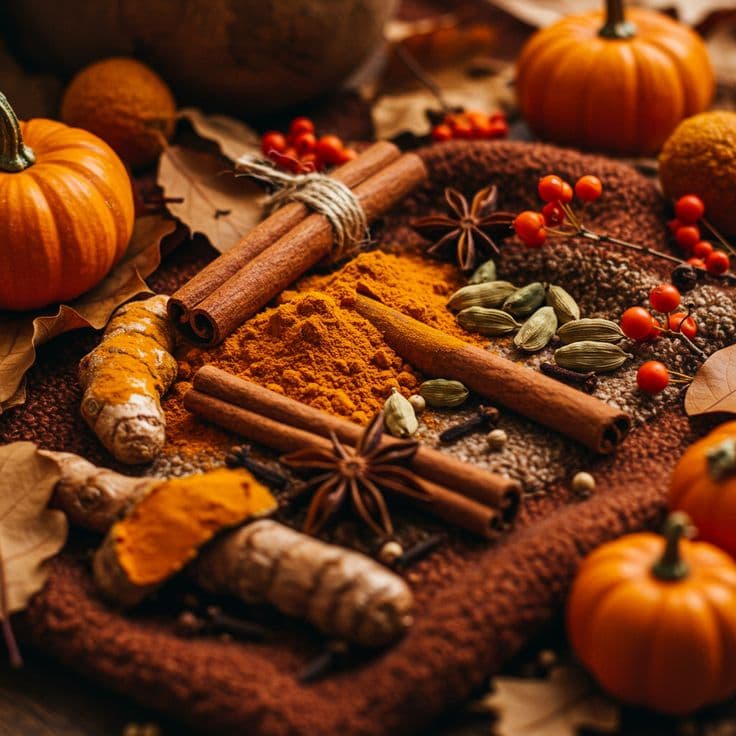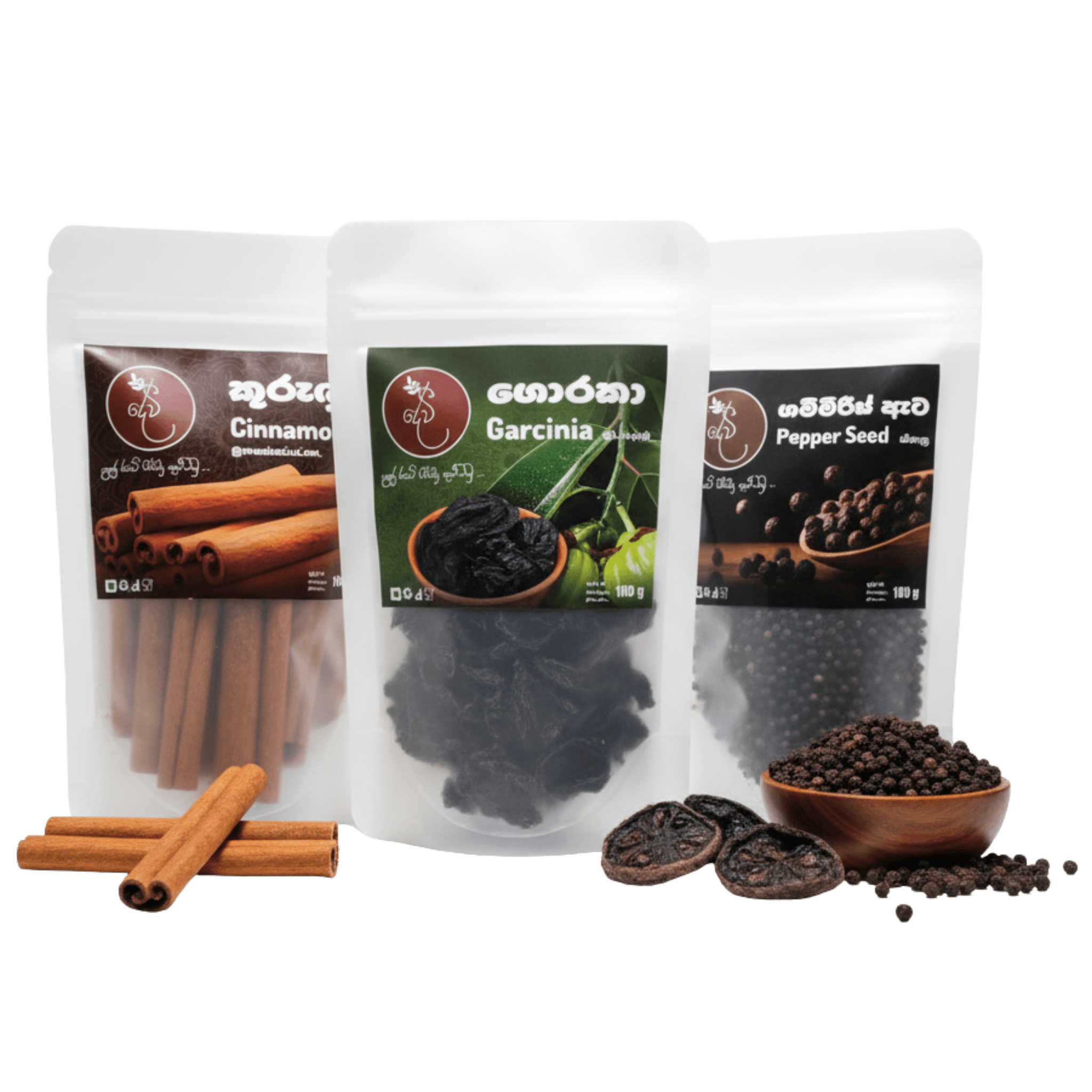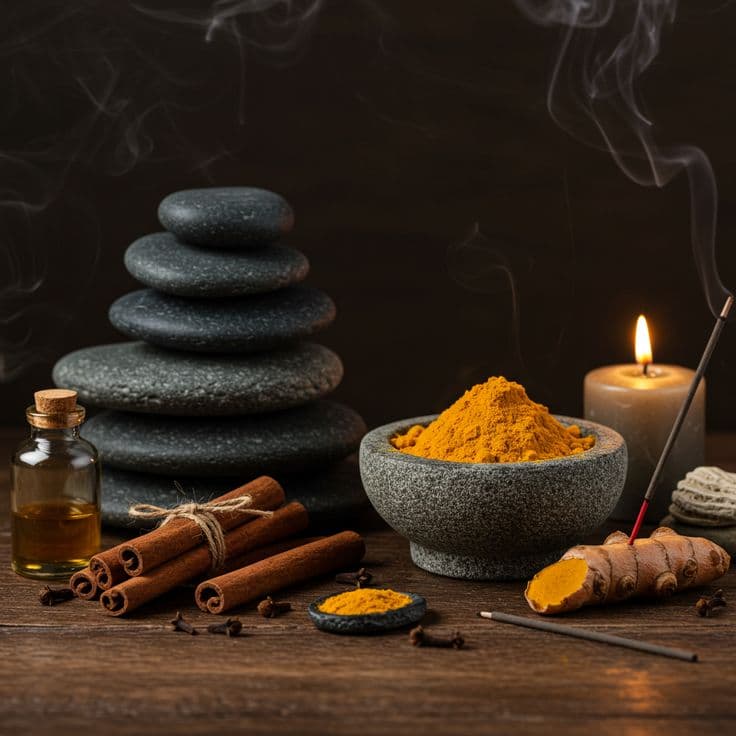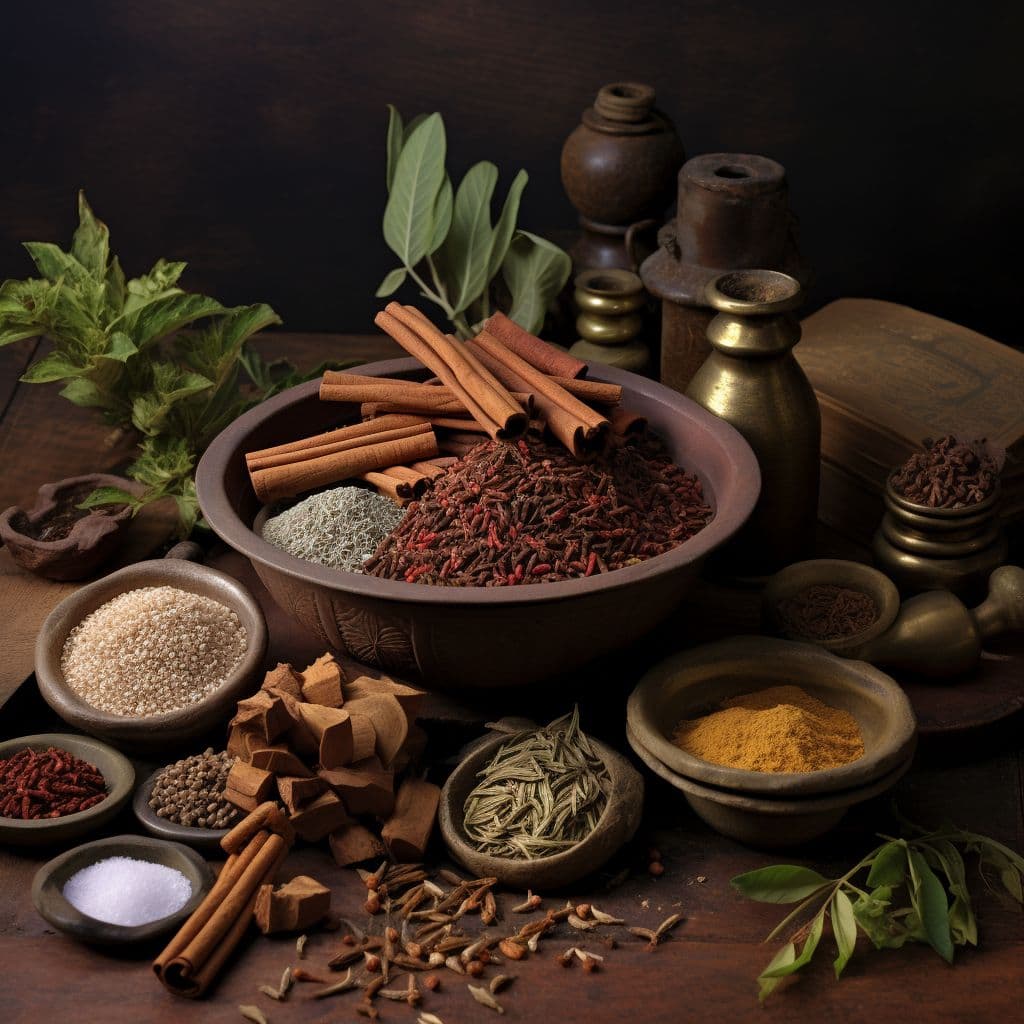
Providing premium spices for health and culinary excellence.
We offer a range of spices that are packed with flavor and nutrients, supporting your wellness and elevating your cooking.
- Rich in Antioxidants
- Boosts Metabolism
- Enhances Flavor
- Supports Digestion

100% Natural, 100% Healthy Spices!
View ProductsOur Most Popular Spices
LKR 390.00
LKR 180.00
LKR 390.00

Authentic Flavors, Ethically Sourced
Offering the finest selection of authentic Sri Lankan spices to nourish your body and elevate your culinary creations.
5+
Spice Varieties
100%
Fresh Guaranteed
10+
Partner Farms
1000+
Happy Customers
Discover True Cinnamon
Cinnamon Sticks
Experience the delicate, sweet flavor of authentic Ceylon Cinnamon. Unlike any other, our cinnamon is sourced from the Cinnamomum verum tree, offering a superior aroma and numerous health benefits. It's the perfect addition to your favorite desserts, warm beverages, and savory dishes. Elevate your cooking with the world's finest cinnamon.
LKR 390.00
What Our Customers Say
Real feedback from our valued customers who love our authentic spices.
"The cinnamon sticks are incredibly fragrant and have elevated my baking. Truly authentic taste!"
Anusha Perera
Colombo, Sri Lanka
"I ordered the spice collection and was blown away by the quality. The flavors are so vibrant and fresh. Highly recommend Devi Products!"
James Smith
London, UK
"As a chef, I am very particular about my spices. Devi Products delivers top-notch quality every time. The turmeric powder is fantastic."
Priya Sharma
Mumbai, India

The Heart of Flavor
Our spices are sourced from the lush, verdant gardens of Sri Lanka, where traditional farming methods yield the purest and most potent flavors.

News & Events
August 23, 2025
August 16, 2025
August 04, 2025

The Perfect Gift for Foodies
Discover our beautifully curated gift boxes, filled with the finest Sri Lankan spices.
Shop GiftsFrom Our Blog
Education
Cinnamon of Sri Lanka: Cultivation, Harvesting, Processing, and Value-Added Potential
Among the world’s most cherished spices, cinnamon comes in two main types; Ceylon cinnamon, known as “true cinnamon,” and Cassia cinnamon. Ceylon cinnamon (Cinnamomum verum), often called “true cinnamon,” and cassia cinnamon (Cinnamomum cassia and related species such as C. burmannii and C. aromaticum) differ significantly in origin, quality, appearance, and chemical composition. Ceylon cinnamon, primarily cultivated in Sri Lanka, has thin, soft, and delicate quills made by layering multiple fragile bark strips, giving it a light tan-brown color and a sweet, subtle, and citrusy flavor. It is more expensive due to the labor-intensive hand-peeling process and its refined aroma. Cassia cinnamon, on the other hand, is commonly grown in China, Indonesia, and Vietnam; it comes in thick, hard, single-layered bark sticks that are dark reddish-brown in color, with a strong, pungent, and somewhat bitter flavor. Chemically, Ceylon cinnamon contains very low levels of coumarin (a natural compound that can be harmful to the liver in high doses), whereas cassia cinnamon has much higher coumarin content, making Ceylon the safer choice for regular consumption. Because of these differences, Ceylon cinnamon is prized in gourmet cooking and the pharmaceutical industry, while cassia, being cheaper and more robust in flavor, is more widely used in processed foods, baked goods, and commercial spice blends. “Ceylon cinnamon” is one of Sri Lanka’s most valuable spices, globally recognized for its unique aroma, flavor, and medicinal properties. Leaves, barks, roots, seeds, side branches are the important parts in a cinnamon plant. Cultivation and processing of cinnamon require skill, precision, and adherence to quality standards, which make Sri Lankan cinnamon stand out in the international market. Cultivation is concentrated mainly in the Southern coastal belt, particularly in Matara, Galle, some parts of Hambantota, Kalutara, and Ratnapura districts, while smaller extents are also found in Matale and Kandy. National Cinnamon Research and Training Center is located in Thihagoda while Kamburupita has the largest cinnamon plant in Sri Lanka. From Plantation to Harvest Cinnamon plants are usually ready for their first harvest about two to three years after planting. It is done after two successive rainy seasons. Because after the rainy season, the bark gets loose and it can be easily removed without any physical damage. The right time to cut the stems depends on the growth cycle of the tree. Farmers wait until the new reddish leaves turn fully green, because at this stage the bark can be peeled more easily. If the tree is flowering or fruiting, the work becomes harder, so harvesting is avoided then. Well-managed plantations can be harvested a few times each year. Continuous harvesting at correct intervals is essential to ensure the production of high-quality grades such as Alba and C grade, while longer gaps between harvests may reduce bark yield and increase woodiness. The correct harvesting technique involves cutting stems at a 45° angle towards the cinnamon bush. And also cutting 1½–2 inches or 1.5 cm above the ground. This technique promotes the outward growth of the new shoots. After cutting, all immature green parts, leaves, and side branches are removed in the field before processing. Harvested cinnamon are transported to the processing shred by land masters or motor bikes. Turning Bark into Cinnamon Once harvested, a deep incision is made from front and opposite side as well as a vertical incision is made using a sharp knife. “Kokeththa” is also used for peeling in early times. The stems are then gently rubbed or massaged by the brass rod to loosen the connective tissues between bark and the stem. Depending on the size and quality, the bark is taken off in wide sheets or as narrow strips. Next, the bark is dried in the peeling shed under shade conditions until it curls naturally. Drying under direct sunlight is not suitable because it will permanently roll the barks. For quill production, bark sheets are stacked together, filled with smaller pieces, and rolled into quills measuring 21 or 42 inches (106.7 cm). Quills are filled with featherings which are called small pieces. The quill length is measured by the “Pethi kotuva”. These are further shade-dried for 4–7 days until the moisture content reaches about 14%. Grading and Varieties Not all cinnamon is the same. In Sri Lanka, quills are sorted by; Diameter of cinnamon quill, Number of sticks of that diameter required to make one kilogram, Percentage of foxing on the surface of quills. Sri Lankan cinnamon is categorized mainly into two types: Heen Kurundu (Smooth Cinnamon): Includes high-value grades such as Alba and C group. Gorosu Kurundu (Coarse Cinnamon): Includes lower grades such as M and H group. The smooth and delicate grades, such as Alba, fetch the highest prices, while the coarser ones are grouped under other categories. Farmers usually aim to produce more of the fine, smooth type because it brings better income. Panni miris kurundu, Thiththa kurundu, Kahata kurundu, Vali kurundu Sevel kurundu, Naga kurundu, Perris kurundu and Panirasa kurundu are some local varieties of cinnamon which are categorized based on pungency, grittiness of the bark and the leaf structure. Different Forms of Cinnamon While quills are the most famous product, cinnamon is also processed into several other forms: · Cut Sticks – shorter versions of quills · Quillings – broken pieces of bark · Featherings – small fragments left during quill-making · Chips – thicker, woody bark not suitable for peeling · Powder and Crushed Cinnamon – made by grinding dried inner bark · Special Cuts – small bark pieces for industrial or culinary use Uses and Value-Added Products Cinnamon is far more than a kitchen spice. It is known for its medicinal benefits, especially for controlling blood sugar, blood pressure, and cholesterol. Its natural anti-bacterial and anti-fungal properties also make it useful in oral care products such as toothpaste and mouthwash. Beyond medicine, cinnamon is a key ingredient in bakery goods, sweets, beverages, and perfumes, making it a truly versatile product with growing demand worldwide. Standards and Global Recognition To maintain its reputation, Sri Lanka follows strict standards in cultivation and processing. In 2022, the country earned the Ceylon Cinnamon Geographical Indication (CCGI) certification, which officially protects the authenticity of Sri Lankan cinnamon. Alongside this, local and international standards such as SLS 81:2021 and ISO 6539:2014 ensure product quality and safety.
Read PostRecipes
Recipe: Authentic Sri Lankan Chicken Curry
Sri Lankan Chicken Curry is a rich, aromatic dish that reflects the island’s culinary heritage. Step 1: Marinate the Chicken - Take 1 kg of chicken pieces (preferably bone-in). - Mix with 1 tsp turmeric, 1 tsp crushed black pepper, 1 tsp salt, and 1 tbsp tamarind paste. - Allow to marinate for at least 30 minutes, ideally overnight. Step 2: Prepare Aromatics - Finely chop 2 large onions, 4 cloves of garlic, and a 1-inch piece of ginger. - Slice 2 medium tomatoes. - Set aside curry leaves and pandan leaves. Step 3: Cook the Base - Heat 3 tbsp of oil in a pan. - Sauté onions until golden brown. - Add garlic, ginger, and curry leaves, cooking for 2-3 minutes. - Add tomatoes and cook until soft. Step 4: Add Spices - Add 1 tsp chili powder, 1 tsp roasted curry powder, 1-2 cardamom pods, and 2 cloves. - Stir to combine and release aromas. Step 5: Cook the Chicken - Add marinated chicken to the pan. - Stir well to coat with the spice mixture. - Cook for 5-7 minutes on medium heat. Step 6: Simmer - Add 1-1.5 cups of water or thin coconut milk. - Bring to a boil, then reduce heat to low. - Cover and simmer for 40-45 minutes until the chicken is tender. Step 7: Adjust Seasoning - Taste and adjust salt and spice levels. - Add more coconut milk for creaminess if desired. Step 8: Serve - Garnish with fresh curry leaves. - Serve hot with steamed rice, yellow rice, or coconut roti. Enjoy the authentic taste of Sri Lankan Chicken Curry, full of bold flavors, aromatic spices, and tender chicken that melts in your mouth.
Read PostWellness
The Health Benefits of Turmeric
In recent years, there has been a growing interest in natural remedies and functional foods as people increasingly turn to traditional knowledge and plant-based solutions for improving health and well-being. Among the most celebrated natural ingredients used in wellness practices are Cinnamon (Cinnamomum verum), Black Pepper (Piper nigrum), and Garcinia (Garcinia gummi-gutta). These three spices, native to South and Southeast Asia—especially Sri Lanka—are not only culinary treasures but also time-tested wellness agents with diverse therapeutic benefits. Cinnamon is known for its sweet aroma and flavor, but its value goes far beyond the kitchen. It contains bioactive compounds such as cinnamaldehyde, which contribute to its powerful antioxidant, anti-inflammatory, and antimicrobial properties. In wellness and traditional medicine, cinnamon has long been used to balance blood sugar levels, boost metabolism, and improve circulation. Many herbal teas and natural supplements include cinnamon for managing insulin sensitivity and reducing the risk of type 2 diabetes. Its warming nature is also believed to support digestive health and enhance immunity, especially during cold seasons. Black Pepper, often referred to as the “king of spices,” is more than a seasoning—it’s a potent wellness enhancer. The active compound piperine is known to improve digestion, stimulate appetite, and most importantly, enhance the bioavailability of other nutrients and herbal compounds. This means that black pepper helps the body absorb more nutrients from food and herbal medicines. Piperine also has antioxidant and anti-inflammatory effects, supporting cellular health and reducing oxidative stress. In Ayurvedic and traditional healing systems, black pepper is used to relieve colds, detoxify the body, and promote respiratory health. Garcinia, known locally in Sri Lanka as goraka, is a tropical fruit commonly used in cooking and Ayurvedic healing. Its rind contains hydroxycitric acid (HCA), a compound widely recognized for its potential to suppress appetite, block fat formation, and support weight management. As a result, Garcinia has become a popular ingredient in many natural weight loss supplements. Beyond its metabolic benefits, garcinia also supports digestive health, reduces acidity, and may help in cleansing the liver. Traditionally, it is used to prepare sour curries that not only taste great but also aid in digestion and body detoxification. Together, these three spices represent a holistic approach to health and well-being. They are commonly found in functional food products, wellness teas, detox blends, and natural health supplements. Their combination can help support metabolism, immunity, digestion, and weight control, making them ideal components in modern wellness practices rooted in traditional wisdom. As the global wellness industry shifts toward sustainable, plant-based, and culturally respectful healing systems, spices like cinnamon, pepper, and garcinia remain at the heart of natural health.
Read PostSelect your spices:












